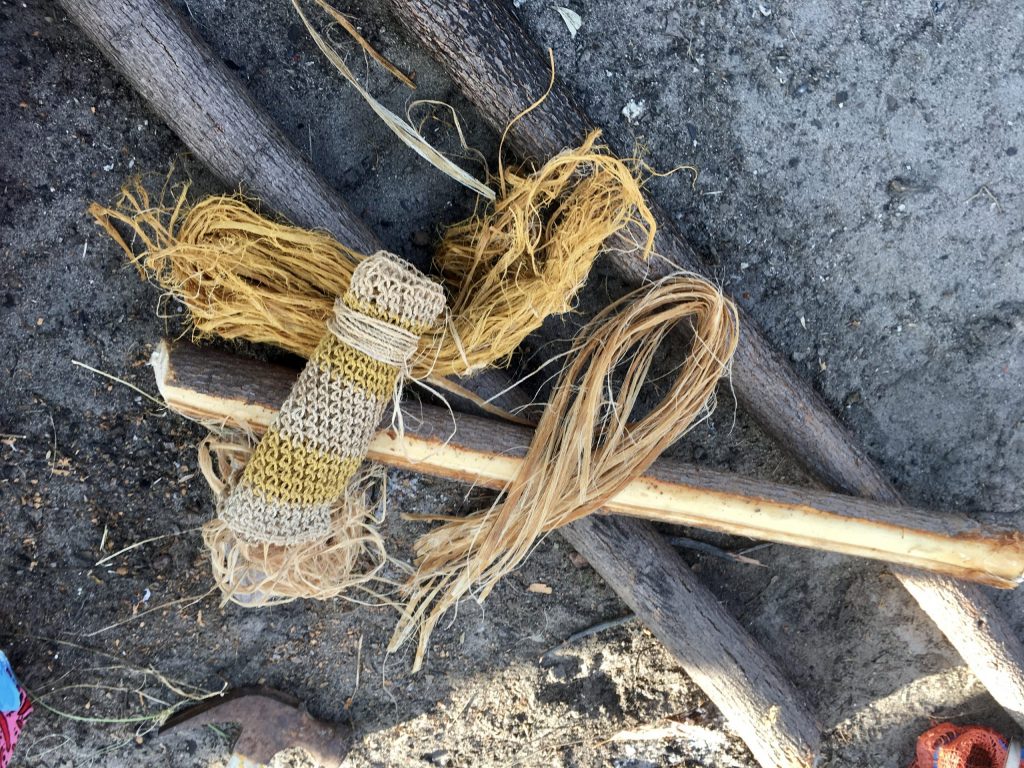
In this article we will be looking at the last of the top 5 essential items you should have with you when you venture into an outdoor environment, and that is cordage. We will look at why it is so important to have with you, types of man made cordage and how to make it from natural resources if you find yourself without it.
Why is cordage so important?
String or cordage is one of the most important resources we can carry with us into the wilderness. We can use cordage to make temporary repairs to equipment and clothing, to fish and make traps, negotiate obstacles such as cliffs or rivers and improvise items for use in camp.
Everything you wear, live in, carry or travel in has something that is holding it together. That could be nails, bolts, screws, clips, ratchet straps, Velcro or modern thread.
In a wilderness environment without modern manufactured items, cordage in the form of string, rope or twine would be and has been used for thousands of years to bind, fix, sew or hold things together.
So having some form of bombproof cordage with you when you venture off into the outdoors is an absolute must.
Modern Cordage
We tend to take cordage for granted today as it is so readily available.
Two of the best forms of modern cordage to have with you in a wilderness environment are parachute cord and bank line.
Both of these forms of cordage are plied cordage, that is, cordage that is not braided and capable of being broken down into smaller fibres.
Parachute cord, also known as Paracord consists of a nylon outer mantle and 7 x 2 ply inner strands. Combined this produces a tensile strength of 550 pounds and is used as the suspension lines on military parachutes, hence the name 550 Paracord.
Having a 20 foot hank of Paracord allows you to have a versatile super strong length of cordage that is able to hold an average grown mans weight and be used to suspend tarps, hammocks and other uses requiring weight bearing cord. The inner strands can be used individually or further broken down to produce trap making material, fishing line, sewing thread or used for whipping or lashing.
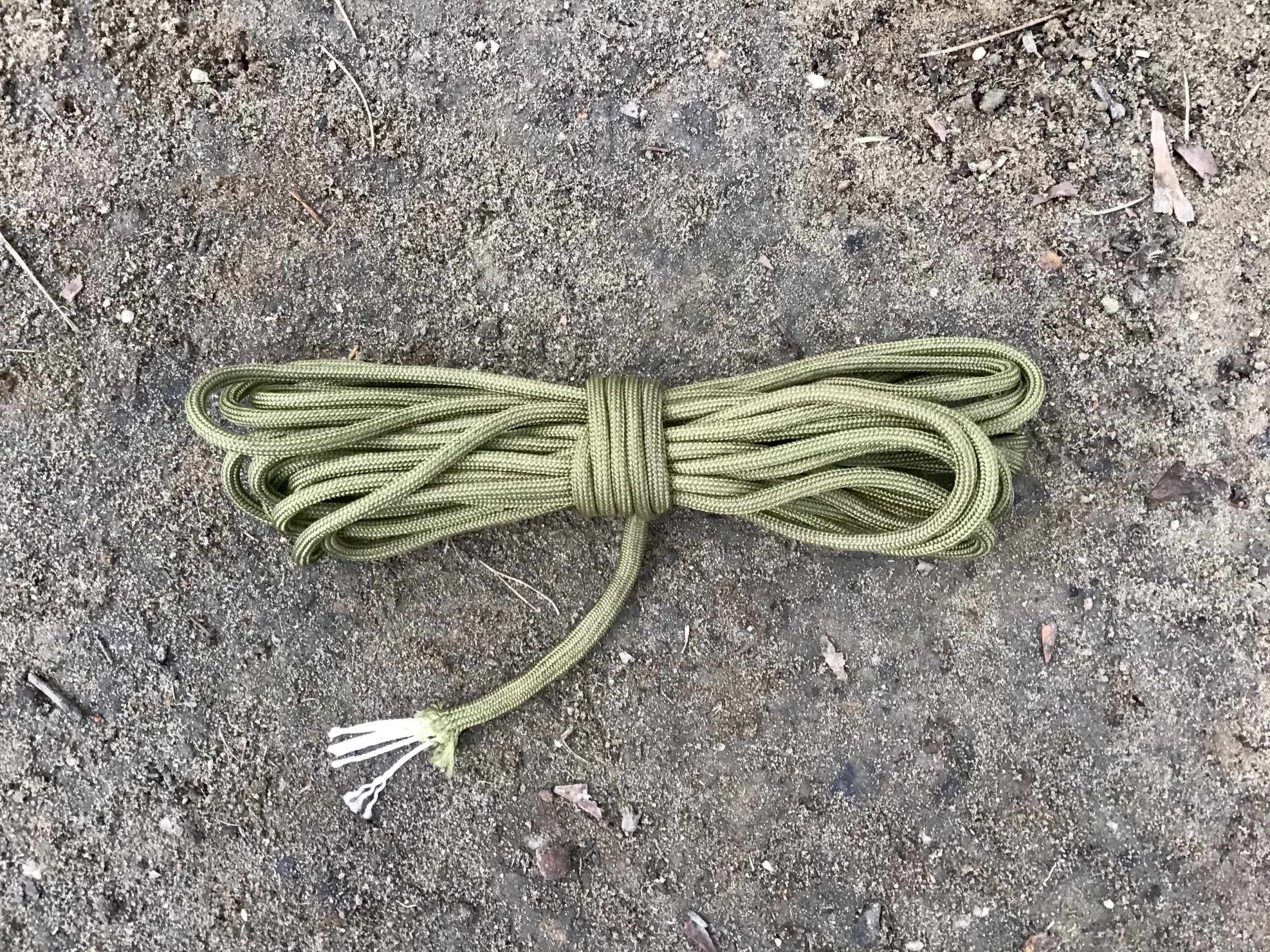 550 Parachute cord with 7 inner 2 ply strands
550 Parachute cord with 7 inner 2 ply strands
Bank line, also known as mariners bank line or tarred bank line is a 3 ply black nylon cordage similar to tennis court netting that is exceptionally strong, is UV resistant and comes in a variety of different diameters.
Its ability to be broken down to smaller fibres as well as being tarred and waterproof makes it ideal for binding, lashing and a myriad of other bushcraft uses.
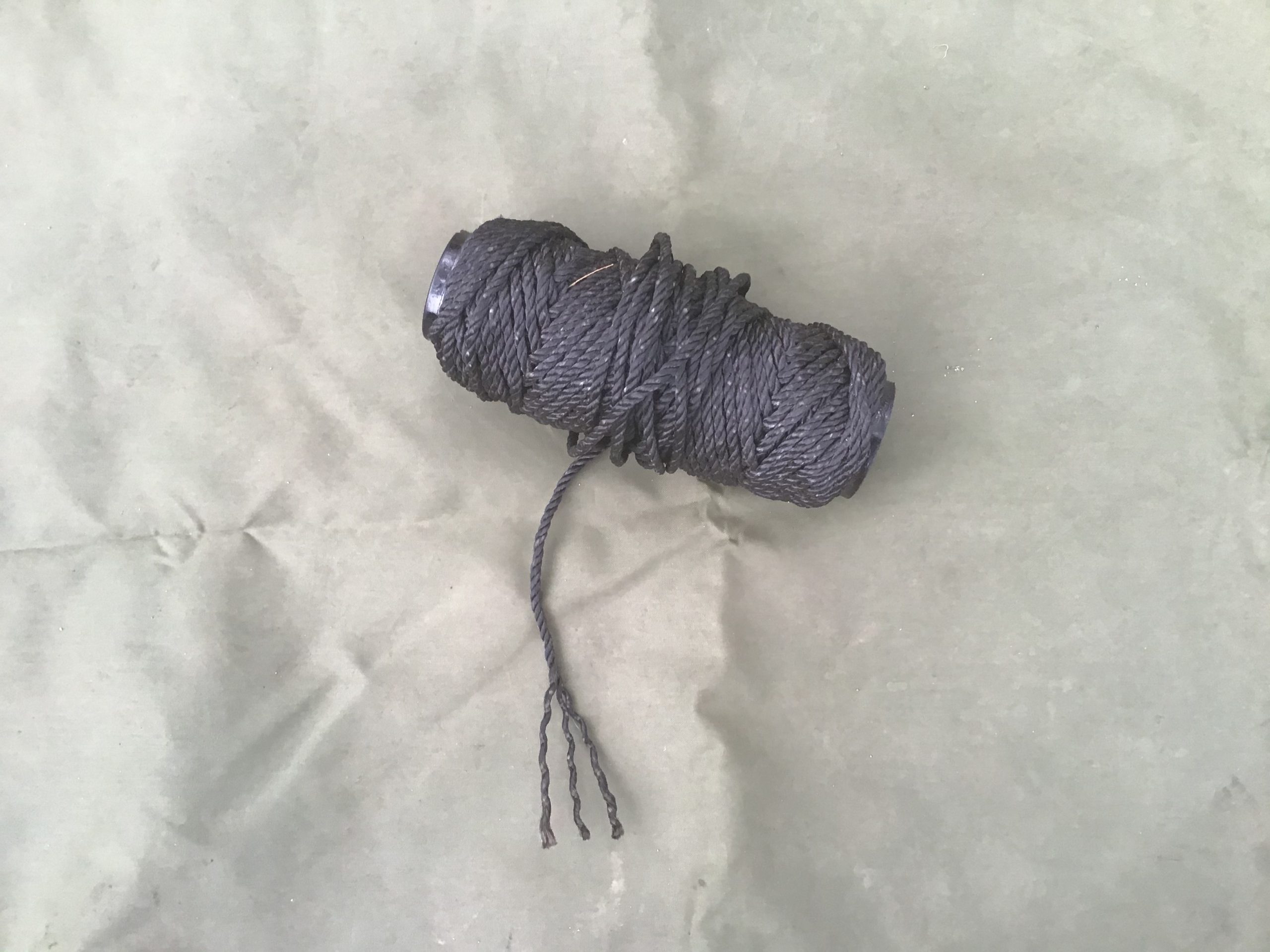 Small roll of #36, 3 ply bank line
Small roll of #36, 3 ply bank line
Having a 20 foot hank (looped bundle of cord) of either Paracord or 3 ply backline is an important necessity to any outdoor kit.
Knots and Hitches
Going hand in hand with cordage is the ability to tie various knots, hitches and lashings. Knowledge of a wide variety of knotting techniques will enable you to tie knots for a variety of different purposes. There are literally hundreds of knots but having at least a minimal knowledge of the important ones is essential. Some of those include the: reef knot, bow line, sheet bend, timber hitch, clove hitch, figure 8, adjustable knot and slip knot to name but a few.
Many people are put off from learning knots and have a mental block when it comes to them. One of the reasons for this in my opinion is because we live in a world now where there is almost a gadget for everything and people have become lazy and lost the ability to carry out simple life skills. Gadgets exist where there should not be gadgets!
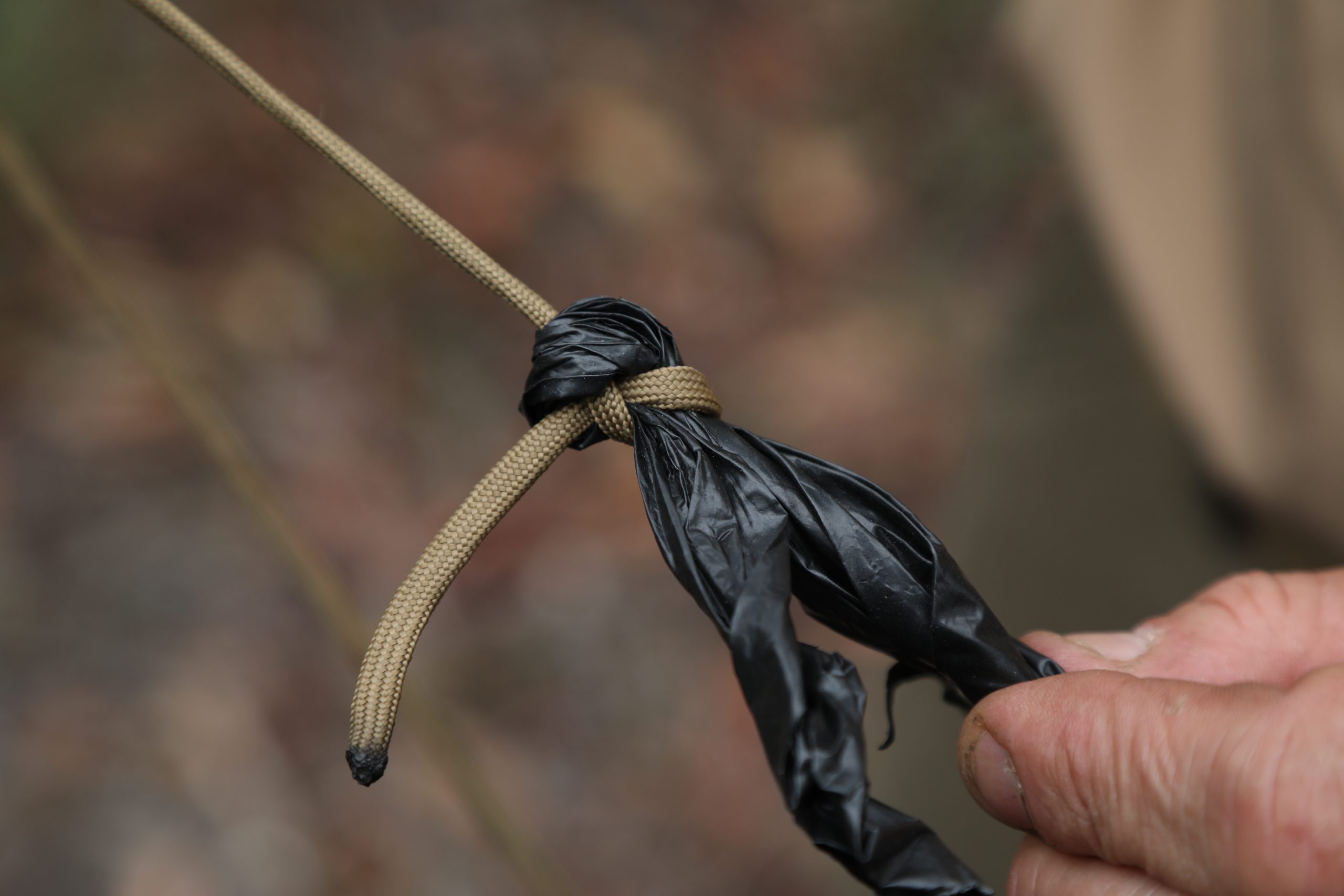 Sheet bend on plastic
Sheet bend on plastic
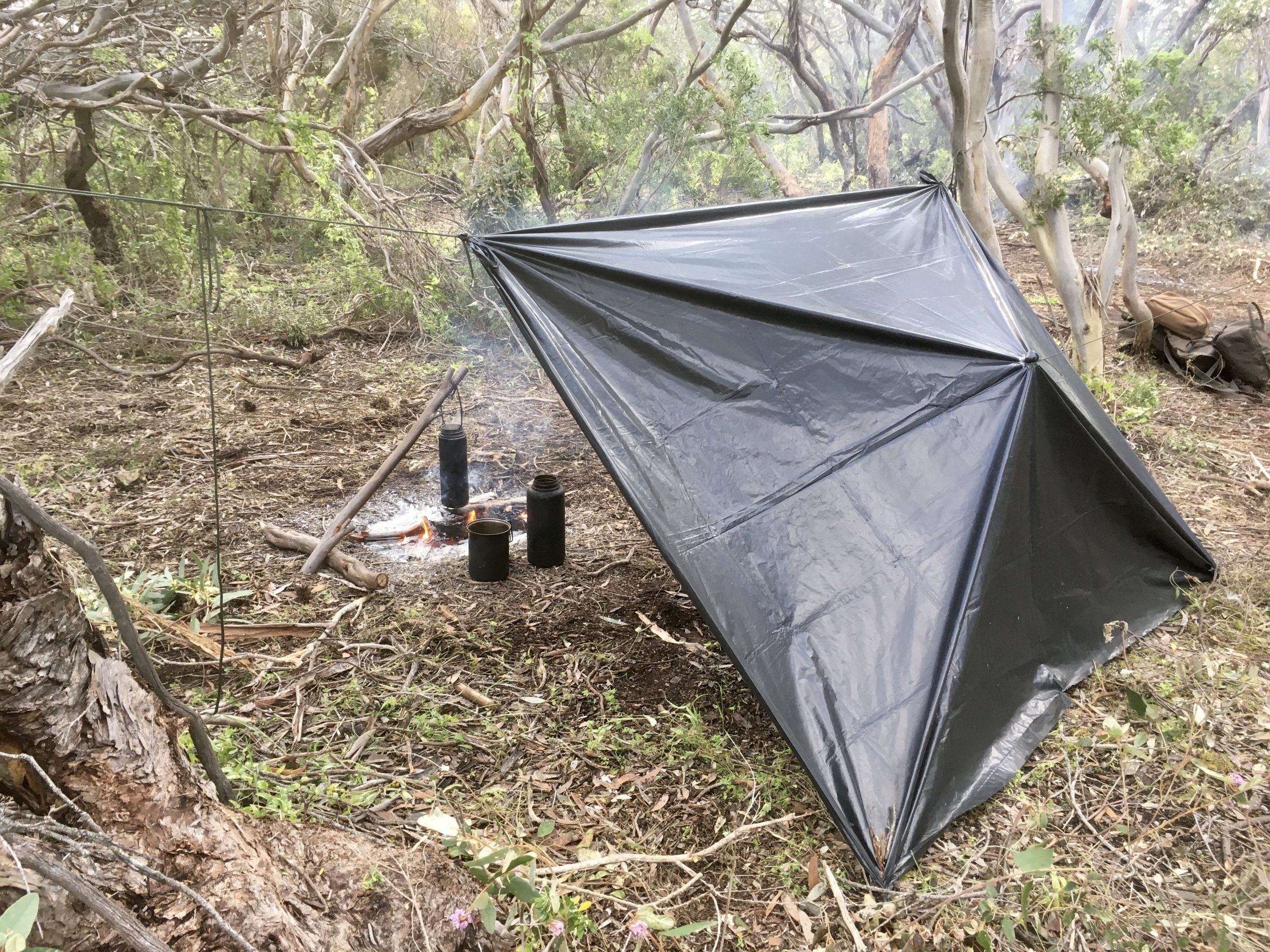 Sheet bends used to secure the corners of an emergency garbage bag shelter. A bush button using a clove hitch is used in the centre.
Sheet bends used to secure the corners of an emergency garbage bag shelter. A bush button using a clove hitch is used in the centre.
Natural cordage and bindcraft
Having the ability to be able to make cordage from the resources you find around you is an important bushcraft skill for anyone who spends time in the outdoors.
Being able to make cordage not only allows you to produce it if you find yourself without it (lack of preparedness) but it allows you to be able to conserve your manufactured cordage and save it for when you really need it.
Good quality natural cordage can be made from a variety of sources:
- Plant Fibres such as the outer fibres of stinging nettle (Urtica sp.) and native raspberry (Rubus parvifolius), leaf fibres and husks of many palms (Livistona sp.) or the semi dried leaves of spiny headed mat rush (Lomandra longifolia).
- the inner bark of many trees such as coastal hibiscus (Hibiscus tiliaceus), Kurrajong (Brachychiton sp.) stringy bark (Eucalyptus tetrodonta) and willow (Salix sp.).
- the shallow long roots of many pines and eucalypts can be split down to make strong lashing material
- making withies involves twisting small pliable saplings so that they are flexible and retain their longitudinal strength, creating a strong bush wire.
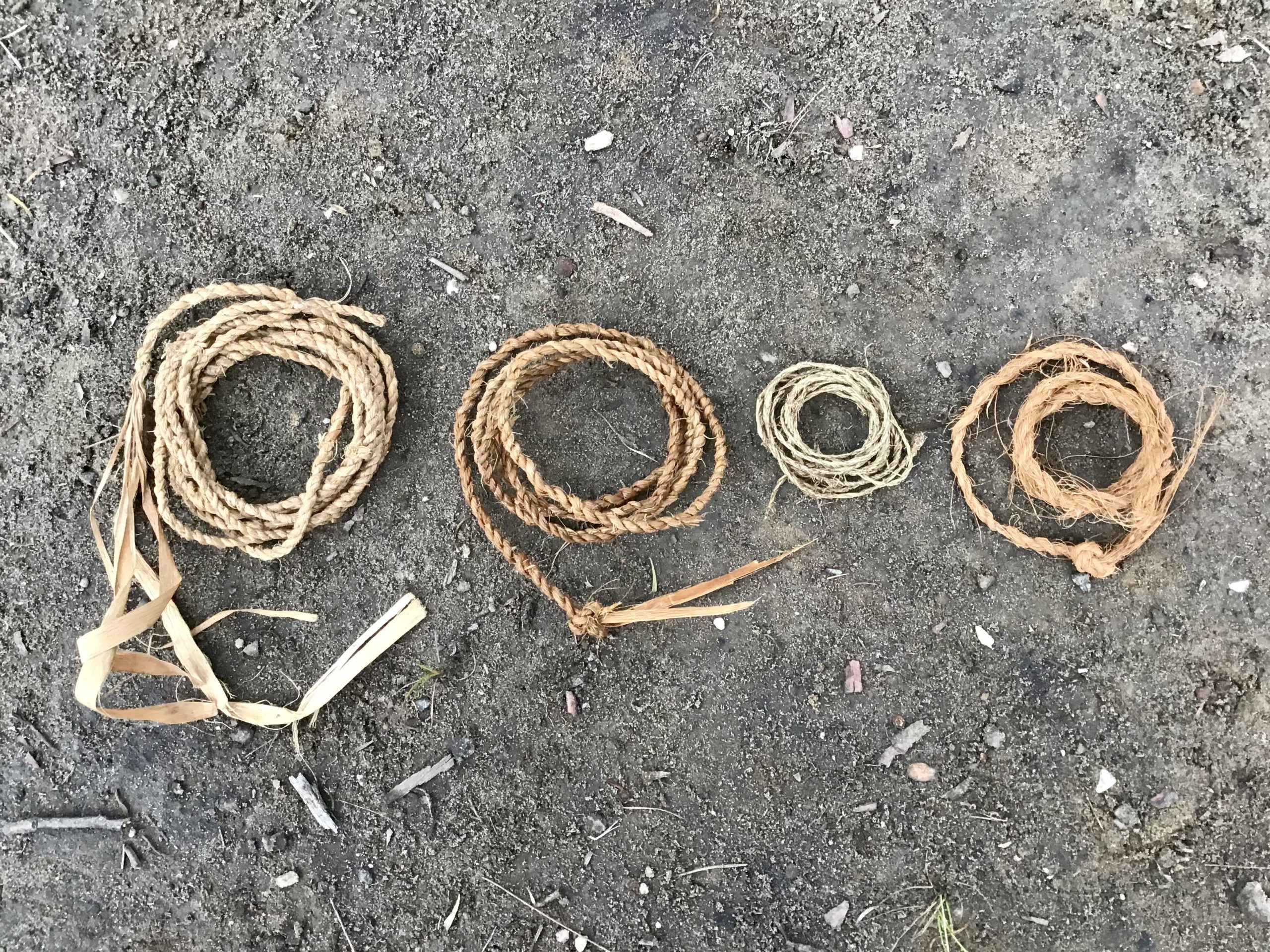 Cordage made from the inner bark of coastal hibiscus, sweet wattle and the fibres of sand palm and coconut husk.
Cordage made from the inner bark of coastal hibiscus, sweet wattle and the fibres of sand palm and coconut husk.
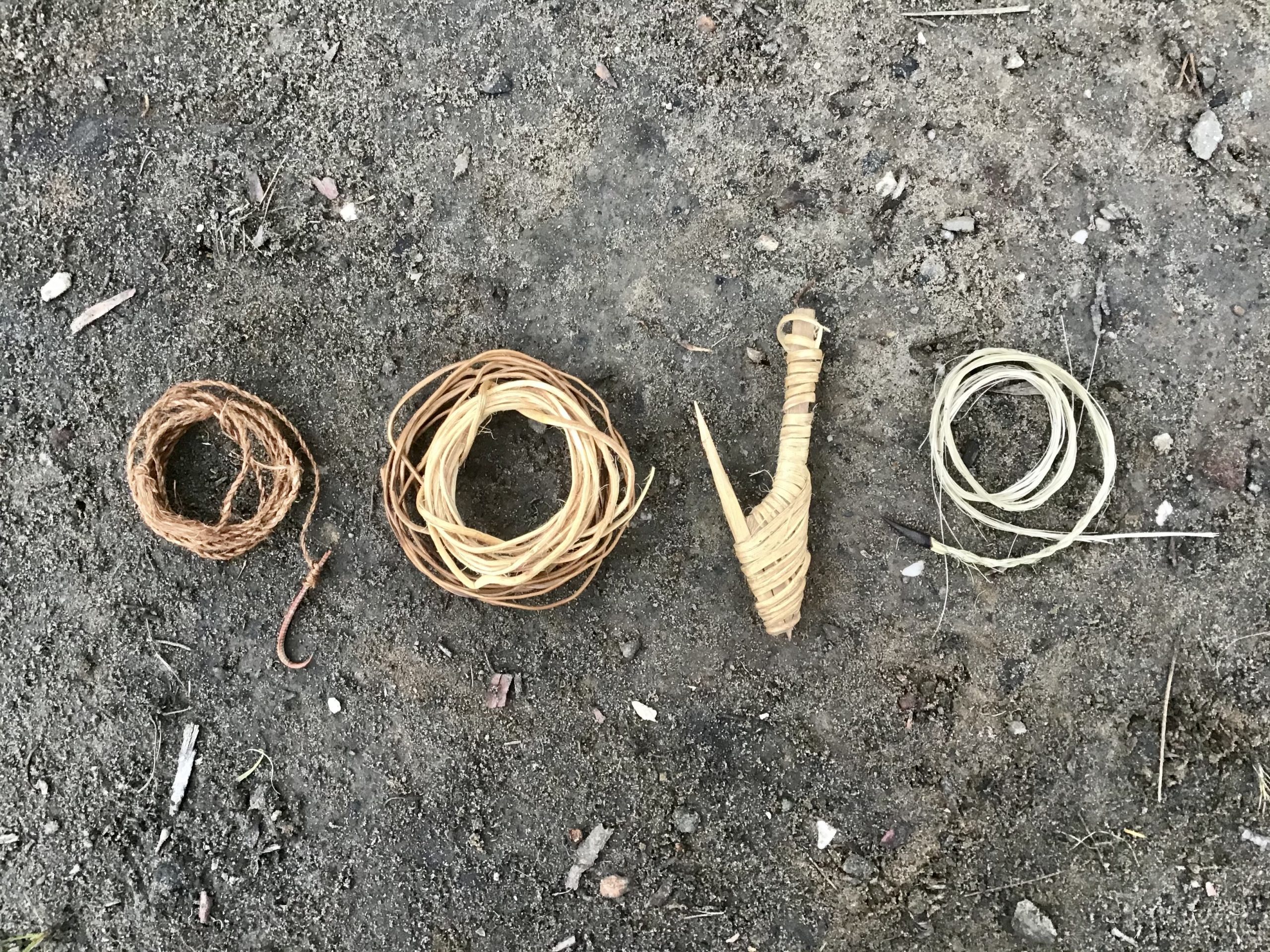 Fishing twine made with dogwood fibre and fish hook cactus, spruce roots, halibut hook lashed with split spruce roots and sewing thread and needle made from the fibres of an Agave leaf.
Fishing twine made with dogwood fibre and fish hook cactus, spruce roots, halibut hook lashed with split spruce roots and sewing thread and needle made from the fibres of an Agave leaf.
There are many methods of making 2 ply cordage, two common methods are the reverse twisting method using your fingers and thumbs and the rolling method which involves rolling the fibres along your thigh or leg.
Once 2 ply cordage has been made it can either be used as it is or platted with other lengths of 2 ply cordage to make rope.
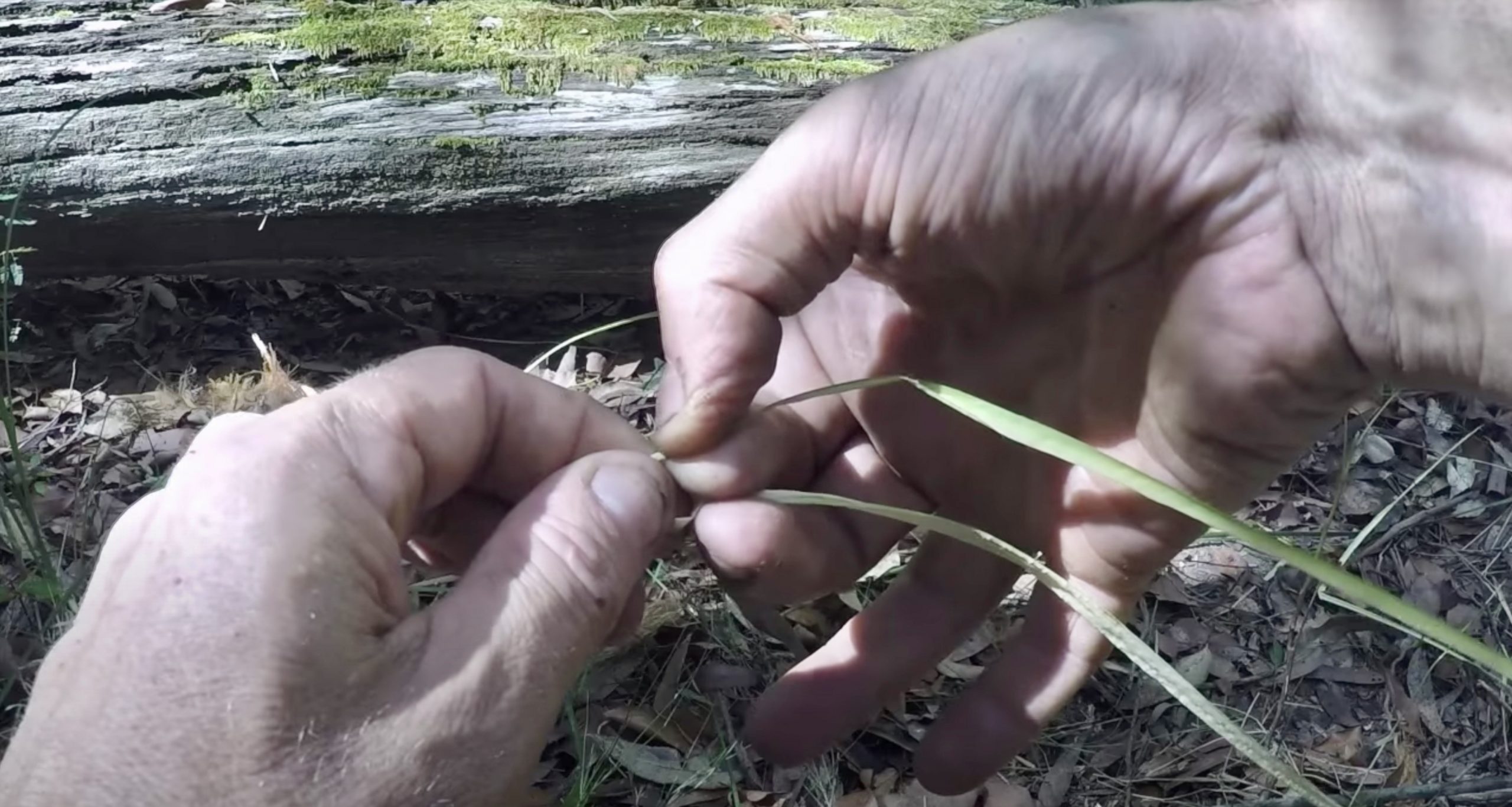 Twisting method
Twisting method
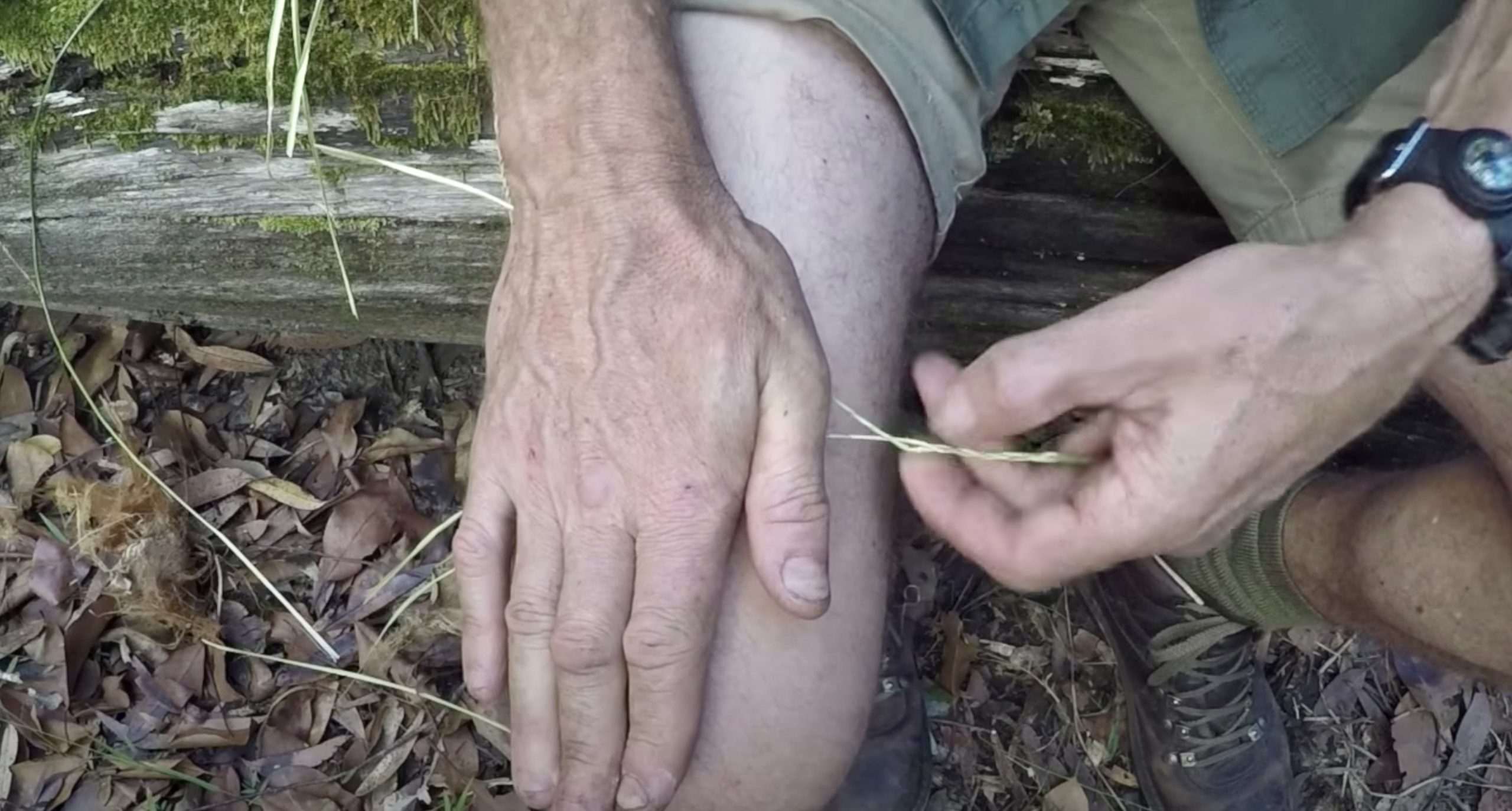 Rolling method
Rolling method
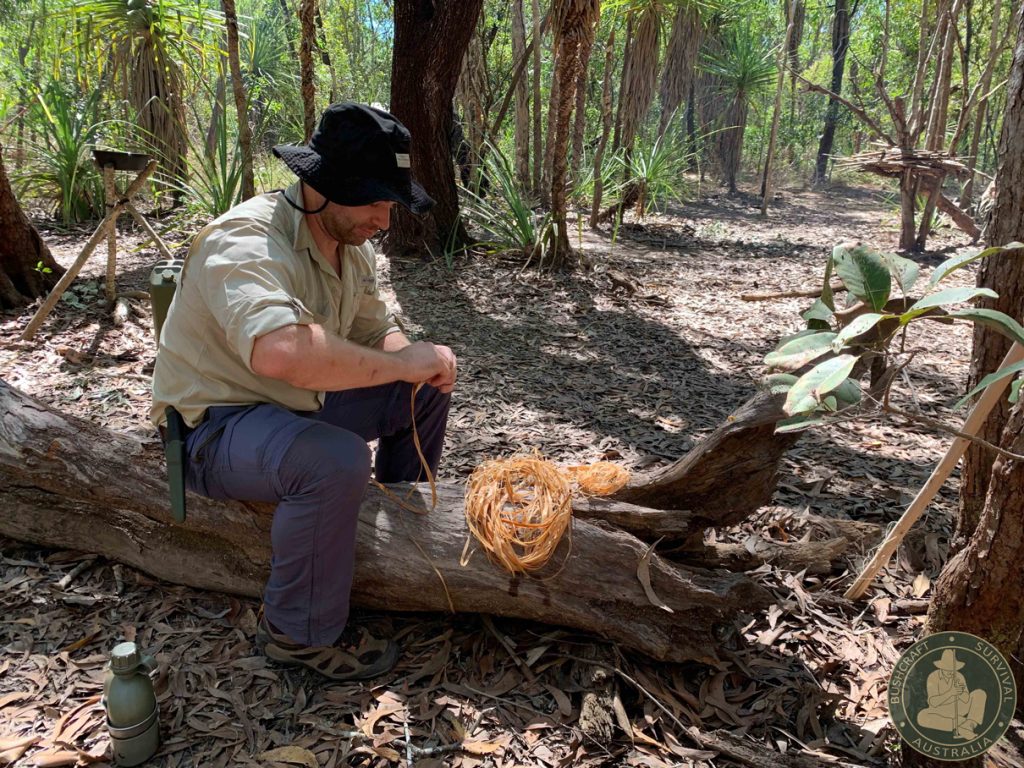 A student on a bushcraft survival course learning how to make natural cordage
A student on a bushcraft survival course learning how to make natural cordage
To see a demonstration of these two methods of making natural cordage please visit our Youtube channel to watch this video: Natural Cordage (Part 1)
“Being overly reliant on any man made equipment in an outdoor environment is a dangerous thing. Sure, having good quality “essential” modern equipment is very important, but not having the knowledge and skill to improvise and manufacture your own alternatives from nature should you find yourself without them is foolhardy and unfortunately very common, especially here in Australia”

Another good article Gordon.
I find with Scouts the kids learn the knots but do not practice them and forget them a quick as they learn them. Knots are a perishable skill in my opinion, they are defiantly worth the time though.
A good source of natural fiber I have found up here is the Neme tree, not a native but a weed that is fast spreading sadly.
Look forward to your next article.
Thanks Justin,
Yes tying knots seems to be a dying art form, but I believe a valuable one that warrants our attention as their are so many benefits from learning them besides the obvious.
I’m not familiar with that tree so will have to check it out when I’m back there.
Gordon
Thanks for the great article Gordo! Such a useful skill to know – I’ll be checking out the youtube for sure.
Thanks Nat, I’m glad you liked it and hope it was useful. Thanks for reading.
Gordon
Hi Gordon,
Could you tell us where to get the good cordage from? My dad has bought 7-ply paracord before, and it did not hold his weight. How do we know if something is real paracord or a cheap copy?
Hi Finn, thanks for your question.
True 550 pound paracord should have an outer sheath (mantle) and 5-7 separate inner strands which are themselves 2 ply (2 strands). The stuff you get from Bunnings for example is NOT true parracord, even though it is labelled as such. It does not have 5-7 inner strands but instead a mess of some other non braided nylon material. True paracord can usually be found at military surplus or disposal stores.. Hope this was helpful.
Hi Gordon,
I found this article very interesting – I didn’t know there were so many plants that you could make natural cordage from!
Hi Simone,
Thank you, glad you found it useful. And that is just scraping the surface!
Best,
Gordon
Hi, just found your website and really like your focus on learning to do things the natural way without lots of modern gadgets.
I see you have videos on YouTube but if you ever offered a hands-on short course (say 3 hrs?) in making cordage from natural materials and learning some knots, I would be very interested and I’m pretty sure others would be. (Sydney-based btw).
Cheers.